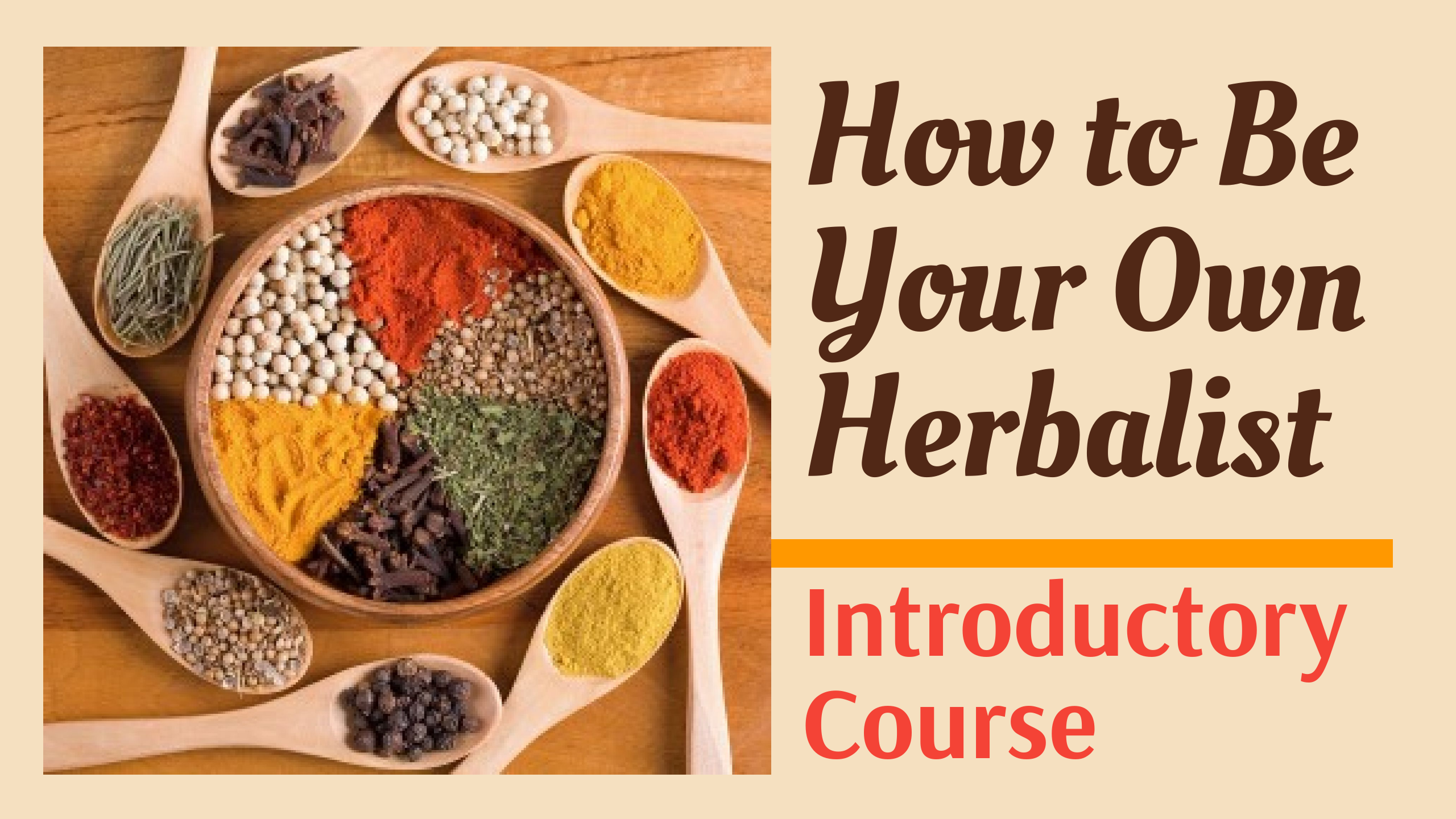IDD

The purpose of the Be Your Own Herbalist course will be to educate laypeople on the basics of herbalism, so they can be better informed about choosing and using herbal remedies and related supplements. The focus of this course will be on educating students to think like an herbalist, and understand the various frameworks for herbal selection, including Ayurveda and TCM. Students will also learn when herbs might be helpful for a condition, and when Western intervention may be necessary. Safety is one of the main focuses of this course; thus, a good portion of the content will focus on the importance of being well-informed about herbal medicine. At the end of the course, students will be encouraged to continue their studies in herbalism.
I am a board-certified Ayurvedic Practitioner (Ayurveda is not yet licensed in the United States) as well as a trained herbalist. I have an Illuminated Herbalism certification from David Crow and completed a comprehensive herbal internship with the renowned herbalist KP Khalsa, who helped found the American Herbalists Guild.
In the advent of the covid pandemic, more and more people have turned to alternative methods of healing. Here in the West, we do not have a strong infrastructure for herbal medicine knowledge or training, and cultural biases often lead to a dismissal of alternative medicine as “pseudoscience.” (In contrast, countries like India have government agencies such as AYUSH that promote the safe use of herbal remedies.) Thus, Western doctors are often poorly trained (if at all) about herbs and their potential interactions with medicines.
Patients, often frustrated with a lack of results from Western medicine, are turning to herbal medicine without any training or knowledge. For whatever the reason, many of these patients are also not seeking help from alternative medicine practitioners or herbalists. Some of this may be due to financial considerations, but some online sentiment seems to indicate a distrust of “experts” in general. Based upon trends observed in online communities, many of these people end up resorting to online communities of peers to get herbal treatment recommendations for everything from fibromyalgia to cancer.
For example, the “Herbalism and natural cures” channel on Telegram has over 61,000 members. While not all the information is bad, there is an alarming tendency for people with no clinical knowledge of herbalism to hand out possible “cures” and canned “protocols” for others in the chat. This is potentially dangerous and counterproductive, leading to negative perceptions of alternative medicine as being unsafe, flaky, or at minimum, ineffective.
The Be Your Own Herbalist course is designed to help promote responsible use of herbs as well as mitigate some of the damage being done by online communities that encourage “armchair herbal diagnostics.” Students will be taught the basics of herbal medicine and how to approach the subject safely and with integrity. They will also be better equipped to distinguish between good and bad advice offered on online forums.
Finally, the course will aim to instill in students a strong respect for the discipline of herbalism and the years of training that go into it. This will hopefully inspire students to either pursue advanced training on their own or, when prudent, consult with professional herbalists and knowledgeable integrative doctors.
In general, the target audience for the Be Your Own Herbalist course is a Western female between the ages of 25 and 55 who is interested in natural remedies. Many, but not all, will have children and families they also want to help with herbal medicine. A subset of this demographic are women with chronic illness who have not been helped with conventional medicine. Please note this does not mean that all learners will be female (and the personas reflect this).
The target audience generally has a middle class income, with a little money to spare to spend on herbal remedies and supplements. Thus, while the target audience should be able to buy some herbs, they may also have concerns about spending too much on health interventions. Therefore, the course should reflect this by providing solutions for money conscious students.
The target audience tends to be skeptical if not outright hostile to Western medicine and traditional doctors, and thus they are actively looking for alternative treatments. Some, but not all, are anti-vaccine activists, but this course is not meant to take stances on highly controversial medical topics and will avoid the topic of vaccines altogether.
The target audience for the basic herb course has been determined in part by analyzing comments at various online holistic healing communities. A large segment of comments was taken from the “Herbalism and natural cures” channel on Telegram and then fed into GPT4o for analysis. The AI was tasked with coming up with learning personas based on the chat topics. The following personas were primarily created via this AI analysis and then modified slightly.
While the personas here imply an American background, potential learners may come from various countries. It is important to note that some countries have much stricter rules regarding herbal medicine and while this will be noted in the course, the primary target for the initial launch is an American/Canadian audience.
Please note that the inclusion of any views in the personas is not meant as endorsement of said views, but is shared as an understanding of the potential learner.
(All persona images are AI generated.)
Name: Sarah
Gender: Female
Age: 50
Background: A nurse and mother of two, one of whom struggles with acne.
Goals: Seeking holistic and safe solutions for her daughter’s health issues, concerned about the side effects of medications like Roaccutane.
Interests: Nutrition, herbal remedies, and preventative health care.
Challenges: Balancing her medical knowledge with the need for alternative treatments that avoid harsh pharmaceuticals.

Name: Jessica
Gender: Female
Age: 30
Background: Social worker. Recently experienced a miscarriage and is looking for ways to regain her health and strength.
Goals: Finding supportive communities and advice on recovery and health optimization.
Interests: Nutrition, mental health, and emotional support.
Challenges: Navigating grief while seeking practical health advice.

Name: Mark
Gender: Male
Age: 40
Background: Online marketer. Actively engages in alternative medicine practices, nootropics, and detox protocols.
Goals: Sharing knowledge on detox treatments and promoting natural medicine solutions.
Interests: Fitness, outdoors, high performance, supplements, detoxification methods, and alternative therapies.
Challenges: Growing his credibility as an online influencer amidst skepticism about alternative medicine.

Name: Alex
Gender: Female
Age: 38
Background: On disability, diagnosed with fibromyalgia and POTS. Struggling with chronic illness for many years, seeking hope and positive reinforcement from others.
Goals: To find motivation and coping strategies from shared experiences in the community.
Interests: Inspirational stories, holistic healing, and community support.
Challenges: Dealing with feelings of despair and the search for effective treatments.

Name: Rachel
Gender: Female
Age: 28
Background: Fitness instructor. Currently following a carnivore diet and exploring detox methods such as coffee enemas. Was exposed to black mold while living in an old apartment building.
Goals: To learn more about detox practices and share experiences with others undergoing similar dietary changes.
Interests: Nutrition, detoxification, and alternative health remedies.
Challenges: Managing the physical effects of detox while seeking validation from peers.

Name: Carla
Gender: Female
Age: 45
Background: A dedicated work-at-home mom who is passionate about natural health practices. She actively researches homeopathy and alternative remedies, often sharing her knowledge with friends and online.
Goals: To educate other parents about the benefits of natural treatments for their children and to advocate for holistic approaches to health, particularly in opposition to vaccine mandates for kids.
Interests: Homeopathy, herbalism, gardening, organic living, and parenting without reliance on traditional medicine.
Challenges: Facing criticism and skepticism from those who support the medical establishment. She seeks to find a supportive community that shares her beliefs while navigating the challenges of raising her children in a world that prioritizes conventional healthcare.

The course type for Be Your Own Herbalist will be a combination of Informational and How-To. This is because a portion of the course will be spent going over basic herbal frameworks, such as Ayurveda, TCM, and Western approaches. Once students have a basic fluency in herbal modalities, the “How-To” portion will focus on how to safely select and use herbs, including dosage, type of delivery method, and length of treatment.
Be Your Own Herbalist will be Asynchronous Online, to best meet the needs of busy people who may not have time to fit live calls into their schedule. Also, this makes it easier to launch the course, because filling up a synchronous online course independently requires an extensive amount of marketing, including a large mailing list, social media reach, and/or advertising spend.
Potentially, a free or low-cost live webinar might be used to introduce the course and get potential students interested in it, but most of the course will be asynchronous.
At the end of the course, students will be able to:
Define the scope of practice for an herbalist in the context of the laws regarding practicing medicine without a license.
Explain the basics of Ayurvedic, TCM, and Western herbal frameworks and list their similarities and differences.
Identify the main herbal energetic qualities and their relationship to a variety of common health conditions.
Evaluate health concerns to determine when to consult a health professional based on herbal scope of practice guidelines.
Select basic herbal remedies for common conditions along with dosage and type of delivery, prioritizing safety by checking any potential contraindications.
Communicate the benefits of herbal remedies ethically and cautiously with awareness of personal knowledge limitations.
Module 3 provides an overview of three major herbal frameworks: Ayurvedic Medicine, Traditional Chinese Medicine (TCM), and Western Herbal Medicine. It covers the historical background, fundamental principles, and key herbs used in each tradition. The module also includes a comparative analysis to highlight the similarities and differences between these systems, and explores how each framework interprets and utilizes herbal energetics to address health conditions.
Explain the basics of the Ayurvedic herbal framework and how Vata, Pitta, and Kapha impact herb selection.
Aligned to Course Learning Outcome (CLO) 2 and 3.
Explain the basics of the TCM herbal framework and its energetics.
Aligned to CLO 2 and 3.
Explain the modern Western herbal framework and how the approach differs from Ayurvedic and TCM.
Aligned to CLO 2 and 3.
Identify key herbs used in Ayurvedic medicine and their primary applications.
Aligned to CLO 3 and 5.
Identify key herbs used in TCM and their primary applications.
Aligned to CLO 3 and 5.
Identify key herbs used in Western herbal medicine and their primary applications.
Aligned to CLO 3 and 5.
Compare and contrast the herbal energetics as understood within Ayurvedic, TCM, and Western traditions.
Aligned to CLO 2 and 3.
These are some of the general learning activities chosen for the Be Your Own Herbalist course (see below for specifics). For initial launch, we will not focus on discussion groups or peer interaction due to limited enrollment.
Lectures and Presentations:
In a Be Your Own Herbalist course, lectures and presentations can provide foundational knowledge about various herbs, their properties, and their uses. Instructors can explain the historical context of herbalism, current scientific research, and safety protocols. Visual aids, such as slides showing plant identification and medicinal preparations, help students grasp the material more effectively.
Problem/Project-Based Learning (PBL):
Problem/Project-Based Learning in a Be Your Own Herbalist course can involve students working on real-life scenarios where they must identify and suggest herbal remedies for specific health conditions. For instance, students might be tasked with creating a treatment plan for a common ailment, using herbs studied in the course. This approach encourages critical thinking and practical application of knowledge.
Hands-On Activities and Labs:
Hands-On Activities and Labs are essential in a Be Your Own Herbalist course as they allow students to directly engage with herbs. Activities might include making tinctures, salves, or herbal teas. Students could also learn to grow and harvest their own herbs, providing a tactile and immersive learning experience that reinforces theoretical knowledge.
Game-Based Learning:
Game-Based Learning can make the study of herbalism interactive and fun. Quizzes, flashcard games, or scavenger hunts involving herb identification can reinforce learning.
Socratic Questioning:
Socratic Questioning in a Be Your Own Herbalist course encourages deep thinking and dialogue. Instructors can ask probing questions about the ethical implications of herbal use, the differences between traditional and modern herbal practices, and the considerations for combining herbs with conventional medicine. This method fosters a deeper understanding and critical evaluation of herbalism.
Please note: We will probably need more lectures so students can understand the basics of each herbal system; this is just an example of possible activities.
Instructional Video on Ayurvedic Principles
Description: Students will watch a pre-recorded video lecture introducing the foundational concepts of Ayurveda, particularly focusing on the herbal framework and the significance of Vata, Pitta, and Kapha in herb selection.
Learning Objective Alignment: Explain the basics of the Ayurvedic herbal framework and how Vata, Pitta, and Kapha impact herb selection.
Reading Assignment: TCM Energetics
Description: Students will read an article explaining the principles of TCM and its energetics, followed by an interactive quiz embedded to reinforce key concepts.
Learning Objective Alignment: Explain the basics of the TCM herbal framework and its energetics.
Comparative Chart Creation
Description: Using an online tool, students will create a visual comparative chart that outlines key similarities and differences between Ayurvedic, TCM, and Western herbal frameworks based on a structured template.
Learning Objective Alignment: Compare and contrast the herbal energetics as understood within Ayurvedic, TCM, and Western traditions.
Virtual Herb Identification Activity
Description: Students will participate in a virtual activity using an interactive game-type application to identify key herbs associated with Ayurveda and TCM, including their properties and uses.
Learning Objective Alignment: Identify key herbs used in Ayurvedic medicine and their primary applications; Identify key herbs used in TCM and their primary applications.
Herbal Selection Practice
Description: The student will specific key herbs for themselves from the Western herbal framework, outlining their applications, benefits, and differences compared to Ayurveda and TCM herbs.
Learning Objective Alignment: Identify key herbs used in Western herbal medicine and their primary applications.
Case Study Analysis
Description: The students will first watch a video with sample case studies. Students then will analyze case studies of their friends/family (or they can make them up) that require them to apply the principles of herbal energetics from one of the three frameworks, justifying herb selections based on learned concepts.
Learning Objective Alignment: Apply the concepts of herbal energetics from any of the three frameworks to specific health conditions.
Knowledge Check Quiz on Ayurvedic Principles
Description: A short online quiz following the video lecture to assess understanding of the Ayurvedic principles related to Vata, Pitta, and Kapha.
Activity Alignment: Instructional Video on Ayurvedic Principles
Learning Objective Alignment: Explain the basics of the Ayurvedic herbal framework and how Vata, Pitta, and Kapha impact herb selection.
Reading Reflection Quiz
Description: Following the reading assignment, students will complete a reflection survey incorporating true/false and multiple-choice questions to demonstrate understanding of TCM principles and energetics.
Activity Alignment: Reading Assignment: TCM Energetics
Learning Objective Alignment: Explain the basics of the TCM herbal framework and its energetics.
Comparative Chart Submission
Description: Evaluate the students' submitted comparative charts for accuracy, clarity, and overall comprehensiveness based on a rubric.
Activity Alignment: Comparative Chart Creation
Learning Objective Alignment: Compare and contrast the herbal energetics as understood within Ayurvedic, TCM, and Western traditions.
Herb Identification Quiz
Description: An online quiz where students identify key herbs they learned about during the virtual herb identification activity, including their uses, benefits, and characteristics.
Activity Alignment: Virtual Herb Identification Activity
Learning Objective Alignment: Identify key herbs used in Ayurvedic medicine and their primary applications; Identify key herbs used in TCM and their primary applications.
Herbal Selection Paper
Description: The student will write a paper based on their choice of Western herbs that will be evaluated based on content quality, depth of research, clarity, and adherence to guidelines.
Activity Alignment: Herbal Selection Practice
Learning Objective Alignment: Identify key herbs used in Western herbal medicine and their primary applications.
Case Study Analysis Report
Description: Students submit a chosen case study analysis report, which will be assessed for understanding of herbal energetics and the soundness of their justifications for herb selections.
Activity Alignment: Case Study Analysis
Learning Objective Alignment: Apply the concepts of herbal energetics from any of the three frameworks to specific health conditions.
The resources I will use for this course will include archived course materials from the Illuminated Herbalism course as well as other courses from David Crow, and course materials and training notes from KP Khalsa. I will also utilize books and materials from Michael Tierra, including PDF files from his Professional Herbalism course.
Subject Matter Expertise - For the solopreneur or influencer, you are likely the Subject Matter Expert. But what specifically is your Subject Matter Expertise? For example, “yoga” is broad. But “yoga for people with arthritis” is a specific area that makes you a Subject Matter Expert (SME).
Target Audience - Who is your target audience? Sometimes this is actually in your Subject Matter Expertise. For example, if your expertise is “yoga for people with arthritis” then your target audience is likely to be people with arthritis. We can drill down even further, however. Are you just targeting older people with arthritis? Or perhaps you want to create a special course for young people with arthritis? Get clear here.
Resources - What resources do you have to complete your course? Are you able to create and edit video? Will you narrate or will you use AI tools like text-to-speech? What learning management system do you have? If you don’t have an LMS yet, this is the time to get one purchased and prepared. You may also need to hire help, such as a video editor.
Outline - During this step, you should create a rough outline of your course along with the number of modules, learning outcomes, and selling points. This is important before the next step.
Outreach - Before you even start developing your course, you should plan your outreach and perhaps create a course pre-launch page to start advertising the course to your mailing list. This is why you need an outline - because you’ll use the outline to pre-sell your course. This is also a good time to put together a comprehensive marketing plan for your course.
Design & Development - This is the stage where you are designing and developing all the learning materials for the course. In the case of a course with live video calls, you should prepare all your slide decks during this stage. It’s also a good idea to create some handouts.
Launch - This is your course launch, when you open it up for full enrollment and get your marketing done. Ideally, you will have already created your marketing plan in the Outreach step, now you just need to implement it.
Engagement - After the course is launched, you will want to engage with your students. This is obvious when you are doing live weekly lectures, but even if your course is pre-recorded, consider ways to keep engaging with your students via forums, office hours, and email. Also, you can use engagement time to get feedback and make adjustments and improvements to your course.
Andragogy emphasizes that adults learn best when they are self-directed and see the relevance of what they are learning. This course will provide learners with opportunities to choose their own learning paths, such as selecting herbs they are most interested in. Additionally, the course will clearly connect herbal knowledge to practical, real-life applications—like creating home remedies or understanding the benefits of specific herbs for health and wellness. By framing the content in a way that directly impacts their daily lives, the course will be more engaging and valuable for adult learners.
Constructivism suggests that learners build new knowledge upon their existing knowledge and experiences. This course will incorporate activities that encourage learners to reflect on their prior experiences with herbs and natural remedies. It will use problem-based learning scenarios where learners can apply their current understanding to solve new challenges, such as identifying herbs for specific conditions or creating their own herbal blends.
Cognitive Load Theory focuses on optimizing the amount of information presented to learners to prevent overwhelm and enhance understanding. This course will break down content into manageable, bite-sized lessons that build progressively. Multimedia elements like instructional videos, infographics, and interactive quizzes will help illustrate complex concepts without overloading the learner's cognitive capacity. Clear, concise instructions and regular summaries will also reinforce learning and ensure that participants can easily follow along and retain information.
Open Educational Resources (OERs) to be included in course:

You can view the full PDF file at this link.
Herbalism 101: A Guide to Plant Medicine Preparations
Handout: https://drive.google.com/file/d/1HLy-pdUYBVXGovio8--sde9Nf1wmNGIG/view?usp=sharing
MP3: https://drive.google.com/file/d/17FnLtHaVyaURbdX1HkSuEDMP9PLtIkXv/view?usp=sharing
OER Checklist: https://drive.google.com/file/d/11rj-hfhlT9mJqquEjpWEZ3NHQbSRfXE1/view?usp=sharing
ALT TEXT = “How to Be Your Own Herbalist – Introductory Course”

OER Checklist for Digital Image:
https://drive.google.com/file/d/16gZlYSZ1KWA2Mal1QmSXBoRObI2QWUnU/view?usp=sharing
Video Link: https://www.youtube.com/watch?v=_8YYpWX6hsc
OER Checklist for Minicourse Video: https://drive.google.com/file/d/1ecqbEPqByQz9wHE8EmuXEErViEYGZnxX/view?usp=sharing
Video Link: https://youtu.be/ttnS6Mb_pwE
OER Checklist for Animation Video: https://drive.google.com/file/d/1g18EsAF0rpSsZm_tsu5k2-KEX84dmdrx/view?usp=sharing
How to Choose Herbs in Ayurveda Storyboard: https://drive.google.com/file/d/1aggTf7aA3YBEGmDeoY4TOLcLzqZB7n28/view?usp=sharing
OER Checklist for Interactive Module:
https://drive.google.com/file/d/1EmzZefhADxncZY2XzCG1AlW8nU03G3Eo/view?usp=drive_link